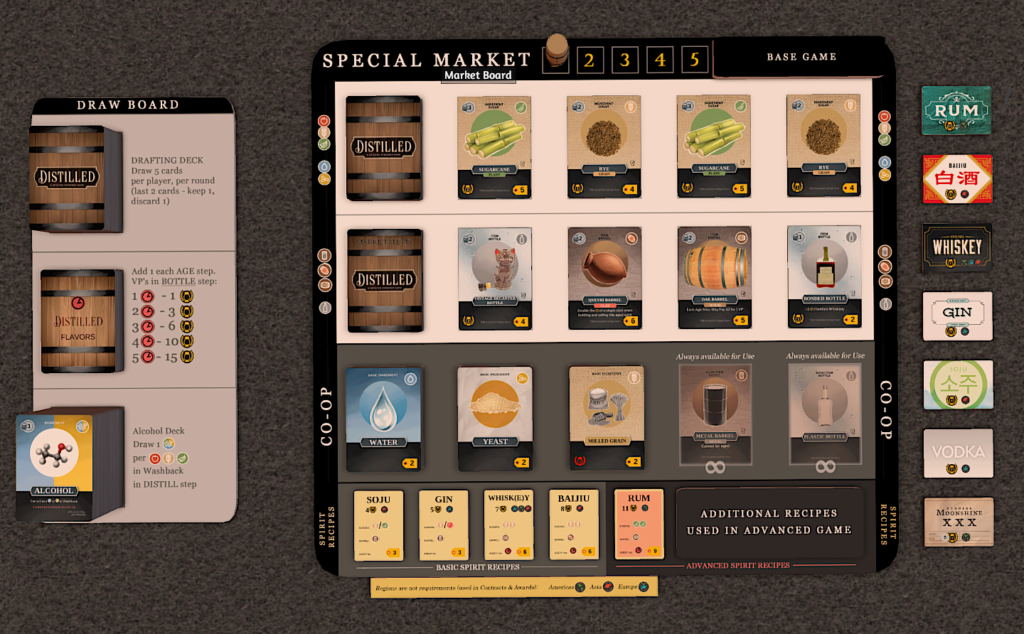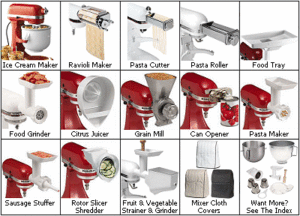I’ve always appreciated a good market in a game. A place where new cards are revealed, keeping the opportunities and visuals fresh with every new turn. That’s one reason I have been holding on to the concept of a market for so long in Distilled, but also why it has gone through so many iterations – anyone can throw some cards down and slap some prices on them, but to create an experience that engages the players while also moving the game forward is a bit harder than one would think.
In this second blog in a four-part series about how I decide to make significant changes to Distilled, I’d like to focus entirely on the Market, as well as certain cards and effects that are connected in some way to that communal space in the middle of the table. If you are just joining me on this journey, I’d recommend you start here, to get the full story, rather than joining this mini-series halfway through the first season 😉

Since Distilled began as a deck building game, I had considered a few (IMO) great markets in deck builders as points of inspiration. Dominion and Thunderstone Quest have static markets, with curated and unique face-up piles containing identical cards, but when purchased will result in amazing combinations in a single future turn. Star Realms and Clank! A Deckbuilding Adventure both have quickly refreshing markets due to players being encouraged to purchase new cards each turn, in hopes of building up one’s fleet or explorer’s party, respectively. And then there is one of my favorites from the deck building genre, Valley of the Kings (Premium Edition), with its gorgeous cards and wonderfully thematic pyramidal waterfall market, where cards only become available once they cascade down to the base of the pyramid.

If you’ve been following along, you know that I’m a sucker for theme in games. My background and interests in both art and history often take precedent – or at least share the spotlight – with my design ideas and goals. This is most obvious in my past artistic projects, such as the indie videogame I released on Steam in 2018 titled Tombeaux. So, when I first conceived of Distilled in the fall of 2019 in Scotland (more on that in a future post!), I knew I wanted a market because of its importance in many deck builders, but I also wanted to thematically represent what it might be like for a distiller to acquire ingredients, items, equipment, and the hiring of skilled workers at a market.
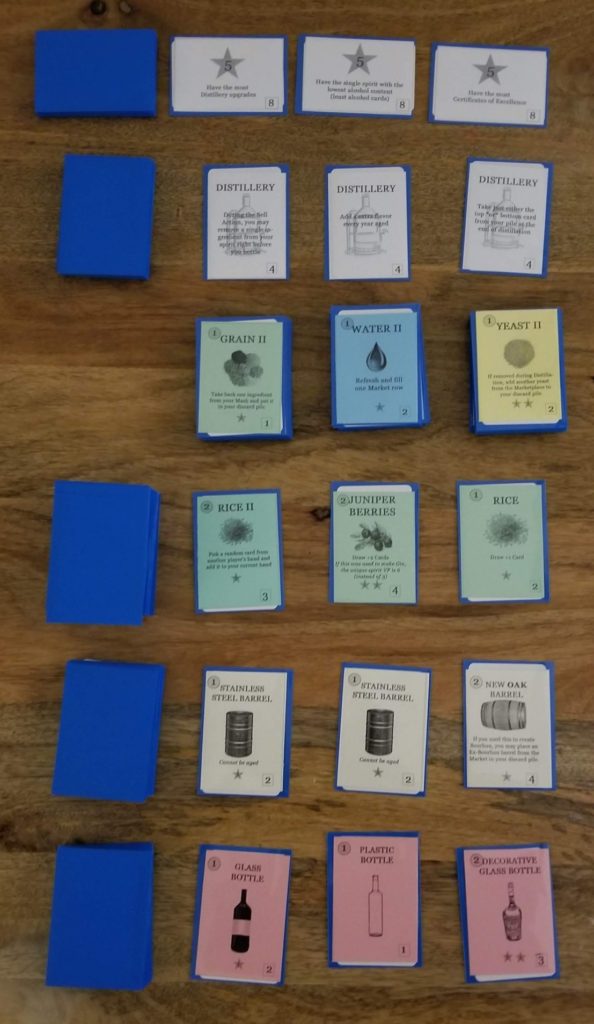
The original market had it all (from top to bottom):
- Various Goals and Achievements players could purchase to hedge their end-game VP bets
- Distillery Upgrades that were different types of equipment one could buy to install on to their playmat
- Piles of face-up Basic Ingredients such as Grain, Water, and Yeast
- Sugar Ingredients that carried specific properties, money, and victory points
- Barrels ranging from metal to clay to wood
- Bottles that could work with any spirit, but provide bonuses if paired with the proper elixir
At this point in Distilled’s design journey (only about 1-2 months into its existence), I was trying to provide everything I could to the player – at a price. Bonus point options, upgrades, required ingredients, thematically fun cards, and lots of effects packed onto every card in the game, but also costing a pretty penny to purchase. While the amazing playtesters I had in the fall were patient and supportive, it became clear that the Market was all too much, regarding choices and table real estate, and become even more apparent as I playtested the game at Protospiel and Con of the North in early 2020. It would take me a few months to realize that I approached the design process for this game backwards – I had created a very complex system that was a bit too overwhelming to the first time player. And if I had to do it again, I wouldn’t change a thing.
You see, I’ve discovered that – while perhaps not entirely efficient – me designing an overly complex system of parts (ie: cards) allows me to see the final version of the game, with all of its potential, right away. Those Distillery Upgrades aren’t in the base game anymore, but they are going to be a fantastic expansion or module that will make the experience for returning players that much more complex and thematically rich (especially with Erik’s illustrations – just you wait until you see those awesome cards!).
For instance, I’ve always been fascinated by the beauty and utility of the Kitchen-Aid mixer. It is essentially a series of motorized gears inside a beautifully designed object that never seems to quit, and does what it is supposed to do – mix something vigorously – quite well. But once you start to add the various attachments on to that object, it can do even more. Pasta maker? Done. Ice Cream? Easy. Meat Grinder? Bring it on. For those who want to take this mixer to the next level, it becomes a truly multi-faceted, essential kitchen machine. And seriously, I’ve been basically doing that with Distilled. I started with the full line of products and add-ons that I know will make gamers appreciate and enjoy Distilled for everything that it is about, but also realize that for a number of users, they need to be introduced to that complexity slowly and gently. So my mantra has continued to be refine, refine, and refine some more – down to the core essence of what makes it a unique and enjoyable, challenging game.
Since late 2019, Distilled has gone through a lot of refinements. Its presence on Tabletop Simulator has allowed for players to provide feedback that might not have surfaced during in-person play, which I’m hoping will result in a more streamlined game experience. As mentioned in the last post, the game transitioned this summer from a deck builder to game that now has a short draft element at the beginning of each round. Players draft a small selection of cards from a larger pool of generally “weak” or “generic” cards. While these cards will get the job done, they’re not going to earn you many victory points or money, so players are encouraged to look to the Market for more prestigious options. Oddly, this is the opposite of a typical draft, which might have unique cards to choose from, but I’ve saved those for the Market, which you’ll see in just a bit.
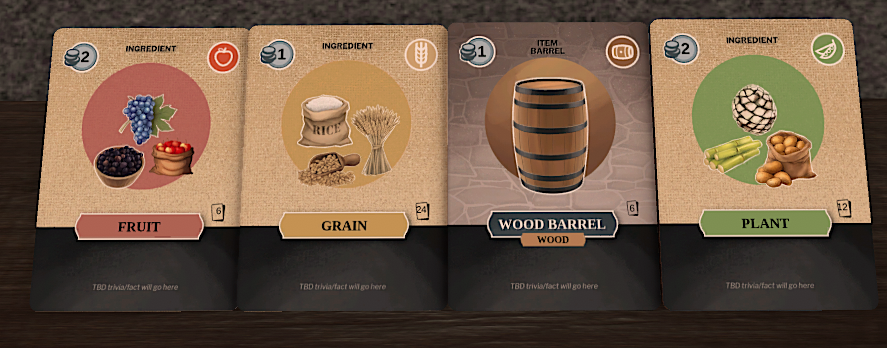
This transition to drafting cards from more “generic” categories is fairly recent in Distilled, but I think it was a successful move in the right direction. No longer does a player need to wait for a “Rice” card to make the famous Korean drink, Soju, but instead they could collect a Grain card and successfully make it as well. But, if they were to skip the Rice card, they will likely be losing out on both money and victory points when they go to actually bottle and sell this spirit. Having this system of broader categories for the ingredients – and thus recipes – has allowed me to design a simple ruleset that is flexible and supportive of a more complex system.
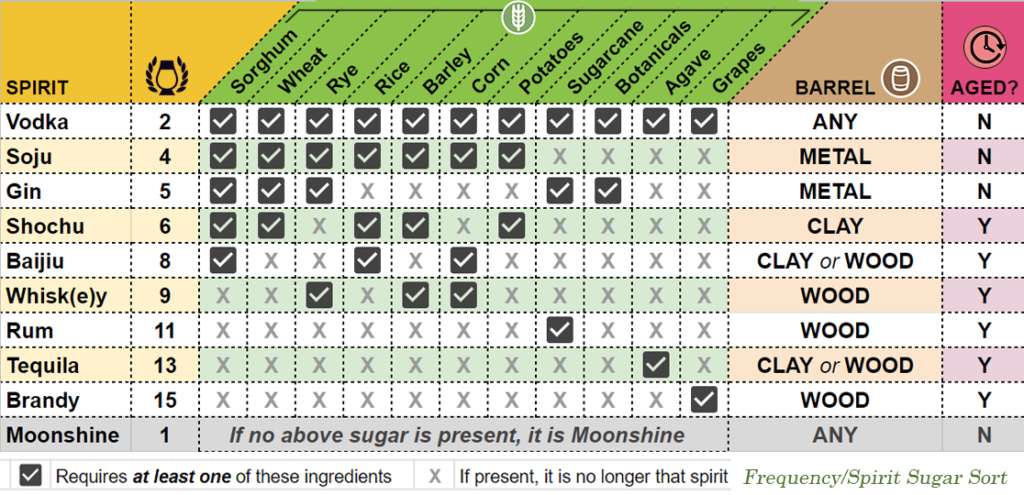
The original “recipe system” I had been working with since the very beginning had specific ingredient requirements for each spirit. Players’ eyes would glaze over looking at this excel spreadsheet, but quickly understand how to read it, but some still did have some complaints. Also, I was not looking forward to asking Erik to try to make this actually visually interesting and simple for players to decipher!

Because of that I came up with a broader category, where each individual ingredient would fall into one of three general areas: “Grain”, “Fruit”, or “Plant” (the name “Plant” is still being tested, along with other names like “Botanicals” and “Vegetables”). This allowed me to not only come up with a far simpler design, but also have the realization that I wouldn’t need a recipe chart at all anymore, and instead I could just simply print the associated icon on a “recipe card”. This got me really excited, as it now allowed for players to “acquire” recipes, as if they were learning a new skill. All players now start out the game with just the knowledge and ability to make Vodka and Moonshine, and they must obtain knowledge (by purchasing the recipes from the Market) to be able to make that particular spirit for the rest of the game. This new “Recipe Market” also allows for vast replay-ability options, as I have plans to include between 15-20 recipes in the base game, allowing players to choose which 5-7 they’d want to play with each session.

In another effort to embrace theme whenever possible, I’ve renamed my “Basic Market” to be the “Co-op” (thanks to a suggestion from a fellow game design friend, Errin). This is the location where you can be guaranteed to obtain basic ingredients and items, so that you can always count on making something each round. Since players can either purchase or trade for cards in the co-op, this allows for additional flexibility for those that might have gotten a bad draft, don’t have any money, or are simply not sure what to do next. Basic Water, Yeast, and Grains are available, as well as a Basic Metal Barrel and Plastic Bottle. These won’t gain you any money or VP (and in the case of the new Milled Grain card, it gives you negative VP) but will insure that you keep on cranking out that white lightning, at the very least.

In the previous version of Distilled, players would have money printed on each card, and they could add that money up to make a purchases from the Market each turn. I’ve changed directions a bit with the new version, and while money still does in fact exist, I’ve decided to incorporate actual coin tokens into the final game, so that players can build up an income and carry it over from round to round. This thematically will enrich the game as well, and allow for me to consider metal coins as a stretch goal or deluxe option in the Kickstarter campaign. I’m especially excited about this, as Distilled will have spirits and distilleries from five distinct international regions in the game – Africa, Asia, Europe, North America, and South America. This diversity of regions will allow for Erik to have some fun with the currency design, as I’ve asked him to design one coin/value for each region (1/3/5/10/20). I absolutely love how Jamey Stegmaier did this with a fictional Eurasia in Scythe, and Distilled’s currency will be attempting to stay true to the culture and region of actual locations, so as to represent those areas with authenticity, along with the distilleries and spirits they are known for as well.
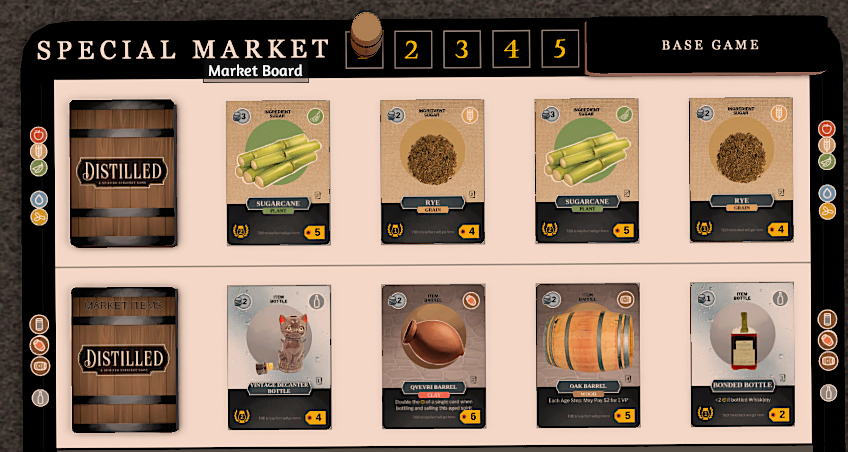
While players now have money to burn – or carry over to another round – they weren’t always spending it in the market as much as I had hoped. I’ve watched games where the market just sits stagnant, with undesirable cards staying in their places all game, which gets boring and – quite frankly – stale. So, I’ve been considering what is called a “river” market for the last month or so, and finally took the plunge in implementing and playtesting it this past week. The concept is similar to what I referenced before with Valley of the Kings – as cards are purchased from one of the rows, the cards shift to the right. Cards that aren’t purchased will find themselves slowly moving to the right of the Market row, and at the end of each round, the right-most card gets discarded, thus having the cards continue slowly down a river to their ultimate discarding demise 😉 The playtests have resulted in a much more engaged market experience, due to seeing cards shuffling through on a more regular basis. Plus, Seth has been able to create a pretty fantastic script that creates a more smooth experience than one usually has in the wonky world of Tabletop Simulator.
To return to theme again, I wanted to end by talking about “Flavors” in Distilled. Knowing that each spirit – especially when aged for a number of years – can take on unique flavor and aroma profiles that one would never expect, I wanted to be sure to try to recreate that experience – and theme – in the gameplay. The Flavor deck sits off to the left of the Market, and instead of something that is purchased, it is a deck that consists of random cards that are meant to represent a tasting journal. Whenever a player ages a spirit in their Warehouse, they draw blindly and add a facedown Flavor card to their barrel. Those cards, along with the rest of their spirit, is described out loud to the table when a player finally bottles their creation. These flavor cards do more than just “add flavor” (sorry) – they also provide compounded victory points based on the rounds (or years) aged and other random bonuses, such as extra money or VP found on each card. I love some of the initial sketches that Erik has come up with and can’t wait to hear what types of spirits people make through their aging process (and am equally excited for the fun expansion that will result in more humorous (and negative!) flavors that have since been removed, such as “Rubber Tires” and “Smelly Socks” (and yes, these are truly flavor notes referenced when sampling spirits!)).
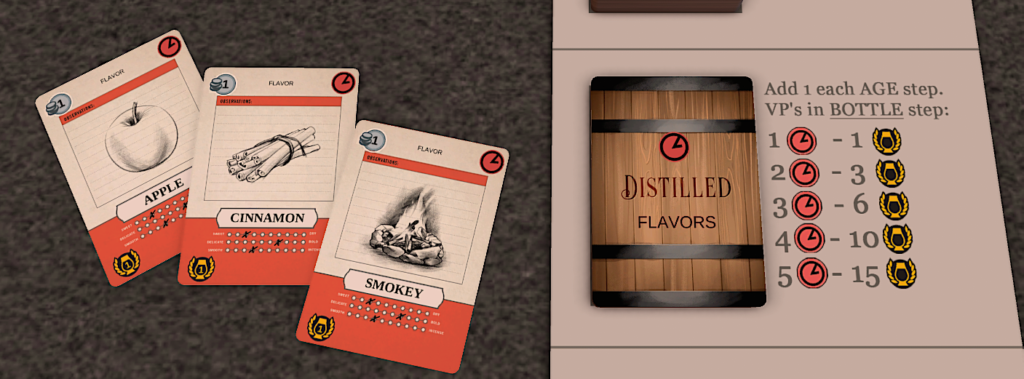
As you can hopefully see by now, a lot of changes have been happening in the center of the table for Distilled. From recipes to co-ops to flavor cards, I’ve been busy refining the experience as best I can, while holding on tightly to the theme that is so important to me as I develop the game for all of you to enjoy. Next time, I’m excited to share all the awesome changes that have been happening with the Playermat, which is the “home base” for each player in Distilled. Until that time comes, I hope you’re enjoying these comments, please feel free to reach out or join the newsletter, and of course…Cheers!
